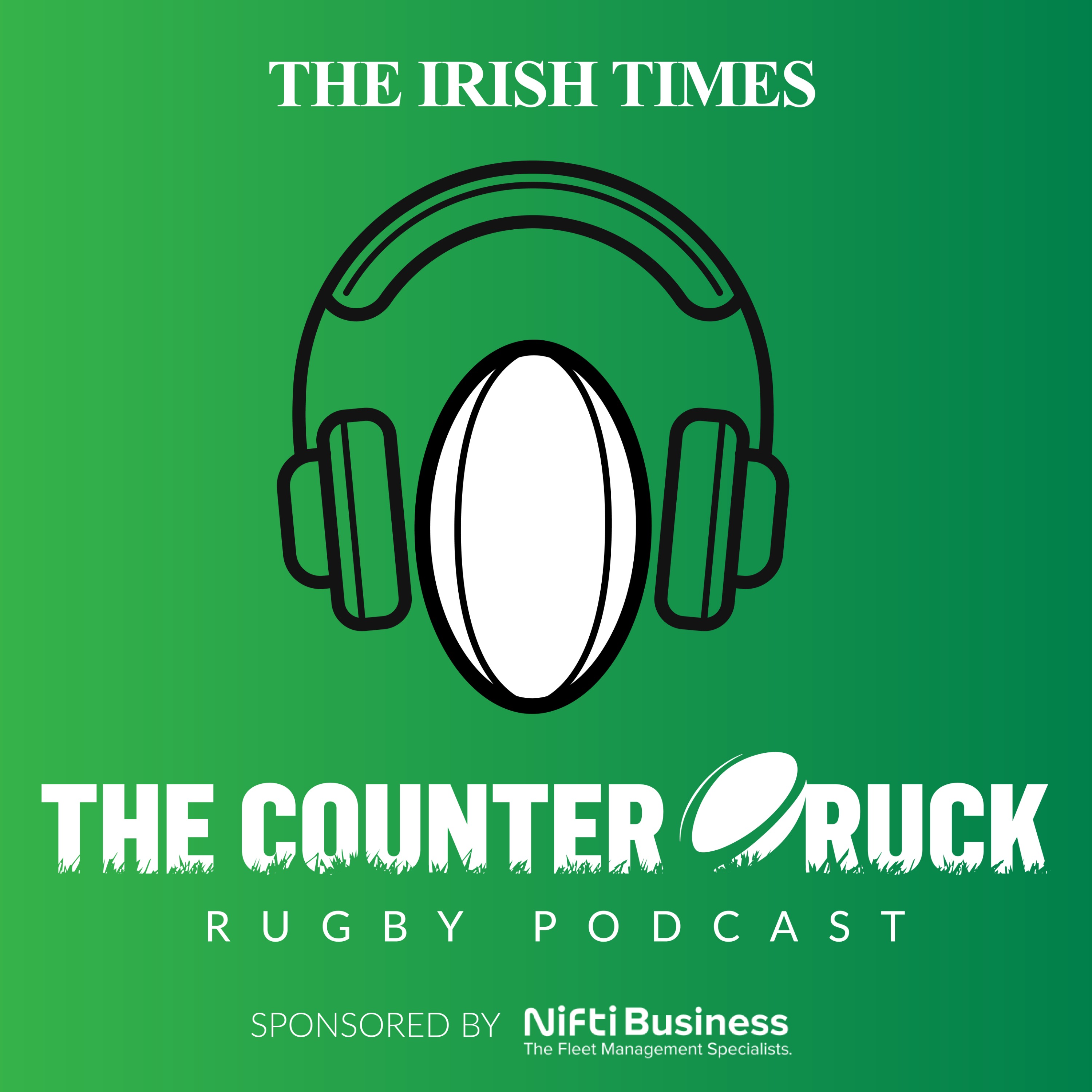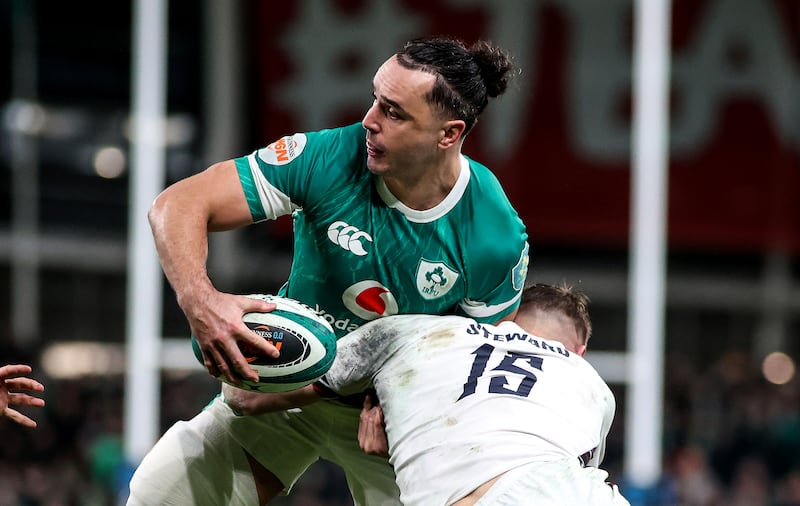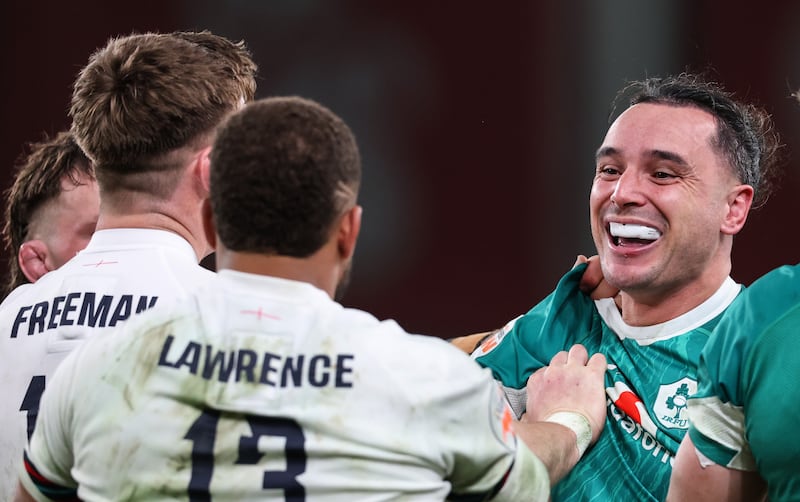James Lowe’s peekaboo moment was match-defining from an Ireland perspective. Initially obscuring himself from the gaze of the English defensive line behind the broad shoulders of team-mate Tadhg Beirne, he showed exquisite timing to appear at full tilt on to Jamison Gibson-Park’s pass, accelerating into the English backfield, an unwelcome interloper.
Steve Borthwick’s visitors didn’t get a fright, because of the split-second timing, oblivious to the danger until too late. Lowe’s game intelligence is finely attuned, possessing the acuity in real time to maximise opportunity.
What the 32-year-old did next guaranteed a try. He occupied England’s final two defenders, Tommy Freeman and Freddie Steward, as they converged in a pincer movement. By veering from one to the other, he attracted both English players, and all that was left for Lowe was to bestow the scoring pass to either Garry Ringrose on his inside or the eventual recipient, Beirne.

Are Ireland Six Nations favourites?
The simplest things are often overlooked; ball in two hands, meander to occupy multiple opponents, slow down for the support. That try on 63 minutes, converted by replacement Jack Crowley, that gave Ireland breathing space, 20-10 on the scoreboard, came 60 seconds after an incident that let the home supporters fearing the worst.
READ MORE
England replacement Chandler Cunningham-South hit Ireland fullback Hugo Keenan in the air. It was a nailed-on penalty. Some 15 minutes earlier referee Ben O’Keeffe had called the respective captains, Caelan Doris and Maro Itoje in, and warned them after yet another scuffle, that “if we have that after the whistle, we will have yellow cards”.

So, when Lowe gave Cunningham-South a nudge to kick-start another melee, the collective intake of breath in the stands was nearly palpable, as was the exhalation when no punishment accrued. Crowley’s penalty to touch and the lineout were precursors to the ruck from which Beirne scored that try.
Lowe earned his break. Apart from a couple of sliced kicks, he was a standout contributor, along with Gibson-Park, to Ireland’s best attacking moments. The two combined for the scrumhalf’s try, Lowe divested himself of Alex Mitchell before he provided Gibson-Park with the chance to send England fullback Freddie Steward “to the shops”, with a sidestep.
There was diligence to the way he applied himself. Chasing kicks can be a thankless chore but it was the speed at which Lowe and Keenan approached Cadan Murley that frightened the England debutant into panicking. Instead of touching the ball down Murley tried to escape the in-goal area and was bundled into touch.
Soon after, hiding in plain sight on the touchline once again, Lowe left Freeman floundering in the English channel out wide, having received a superb cut-out pass from Dan Sheehan, before rewarding the replacement hooker’s industrious trail-line with a try-scoring pass.
Lowe’s influence wasn’t compromised by the bang he received to his quad that required strapping, nor by the fact that he had played just one match, Leinster’s URC victory over the Stormers, since damaging a calf in Ireland’s final Autumn Nations Series game against Australia.
He was sharp, too, in defence, hustling cleverly to cut off the options for Marcus Smith after the England outhalf had made a fine break, and taking a high ball over his head, GAA style. His aerial work was first class in both defence and winning a tap-back or two.

Then there were “zero-talent” contributions to which players and coaches refer or clearing out, getting off the ground quickly to get back in the defensive line. Lowe has shown the capacity to win collisions with his head, first, as much as that innate physical power: it’s the lines he runs, his timing on to the ball, the precision dip of the shoulder to break a tackle.
When not hiding in plain sight, he was content to participate in skirmishes, verbal (Freeman) or physical; the latter involved wrestling on the ground with Steward. In bookmarking all of those in-match “wins” for his team, it can be easy to tune out from the bigger picture. In a nutshell Lowe makes Ireland a better team because he has the capacity to do things that others can’t see or pull off.
One example cam when Sam Prendergast cross-kicked to his wing. Lowe caught the ball and kicked it in one fluid motion, aware of the incoming tackle. Skills.
He had spoken before the match about his nervous excitement. Afterwards he sifted through the pros and cons. “We played okay, it took us a while to get up and running, we were a bit disappointed, a bit deflated at the end (in conceding the two tries) but to beat England at home in round one of the Six Nations, it can’t get much better.
“Come Monday we will be straight back to the drawing board seeing what we can do better because there is definitely another level in us and Scotland being the attacking minded team that they are, it is no easy task [to go to Murrayfield] and win.”
Footnote: Lowe is an early favourite for any Six Nations Championship hide-and-seek title.






















